Abstract
A new series of homosulfocoumarins (3H-1,2-benzoxathiepine 2,2-dioxides) possessing various substitution patterns and moieties in the 7, 8 or 9 position of the heterocylic ring were prepared by original procedures and investigated for the inhibition of four physiologically relevant carbonic anhydrase (CA, EC 4.2.1.1) isoforms, the human (h) hCA I, II, IX and XII. The 8-substituted homosulfocoumarins were the most effective hCA IX/XII inhibitors followed by the 7-substituted derivatives, whereas the substitution pattern in position 9 led to less effective binders for the transmembrane, tumour-associated isoforms IX/XII. The cytosolic isoforms hCA I and II were not inhibited by these compounds, similar to the sulfocoumarins/coumarins investigated earlier. As hCA IX and XII are validated anti-tumour targets, with one sulphonamide (SLC-0111) in Phase Ib/II clinical trials, finding derivatives with better selectivity for inhibiting the tumour-associated isoforms over the cytosolic ones, as the homosulfocoumarins reported here, is of crucial importance.
1. Introduction
Carbonic anhydrases (CAs, EC 4.2.1.1) are metalloenzymes widespread in nature, being encoded by at least eight different genetic families, which have been identified in organisms all over the phylogenetic treeCitation1–3. By catalysing a crucial physiologic reaction, by which CO2 is hydrated with the formation of a weak base (bicarbonate) and a strong acid (hydronium ions), these enzymes are involved in a multitude of physiologic processes, starting with pH regulation and ending with metabolismCitation1,Citation3–6. As thus, CAs are drug targets for decades, with their inhibitors having pharmacological applications in a multitude of fieldsCitation1,Citation3–5. The primary sulphonamides were discovered as CA inhibitors (CAIs) in the 40 s, and most of the drugs that were launched in the next decades as diuretics, antiepileptics, or antiglaucoma agents targeting CAs belonged to this class of compoundsCitation1,Citation3–5. Although highly effective as CAIsCitation1, the sulphonamides generally indiscriminately inhibit most α-CA isoforms present in mammals (at least 15 in humans, and 16 in other vertebratesCitation1) as well as CAs belonging to the other genetic families (β-, γ-, δ-, ζ-, η-, θ- and ι-CAs)Citation2–5 and for this reason alternative CAI classes were searched for. In fact, in the last 10 years, a multitude of new chemotypes as well as novel CA inhibition mechanisms were reportedCitation1,Citation4,Citation7–9, which highly enriched our understanding of these enzymes and also allowed for obtaining isoform-selective CAIs targeting all the mammalian isoformsCitation4,Citation7–9. Among the new such chemotypes, which also showed the highest levels of isoform selectivity, were the coumarinsCitation9, the sulfocoumarinsCitation7,Citation8 and their congeners, homosulfocoumarins (3H-1,2-benzoxathiepine 2,2-dioxides)Citation10. Considering the fact that this last chemotype was only recently reported and rather poorly investigatedCitation10, we report here a series of new aryl-3H-1,2-benzoxathiepine 2,2-dioxides substituted in various positions of the heterocyclic ring, which have been designed in order to explore the chemical space around this new CA inhibitory chemotype and to see whether the presence of various moieties in position 7, 8 or 9 of the heterocyclic system maintains the desired enzyme inhibitory activity and selectivity for the target isoforms.
2. Materials and methods
2.1. Chemistry
Reagents, starting materials and solvents were obtained from commercial sources and used as received. Thin-layer chromatography was performed on silica gel, spots were visualised with UV light (254 and 365 nm). Melting points were determined on an OptiMelt automated melting point system. IR spectra were recorded on Shimadzu FTIR IR Prestige-21 spectrometer. NMR spectra were recorded on Bruker Advance Neo (400 MHz) spectrometer with chemical shifts values (δ) in ppm relative to TMS using the residual DMSO-d6 signal (1H 2.50; 13 C 39.52) or CDCl3 signal (1H 7.26; 13 C 77.16) as an internal standard. High-resolution mass spectra (HRMS) were recorded on a mass spectrometer with a Q-TOF micro mass analyser using the ESI technique. Elemental analyses were measured using Carlo Erba (EA1108) apparatus (Milan, Italy).
2-Hydroxy-5-iodobenzaldehyde (2)
 To a solution of salicylaldehyde (1) (8.73 mL, 81.9 mmol) in AcOH (40 mL) iodine monochloride (4.92 mL, 98.3 mmol) was addedCitation11. Reaction mixture was stirred 24 h at 40 °C, then cooled to r.t. EtOH (60 mL) was added and all volatiles were removed in vacuum. CH2Cl2 (60 mL) and water (100 mL) were added, the phases were separated and the aqueous phase was extracted with CH2Cl2 (3 × 50 mL). The combined organic phases were washed with 10% Na2S2O3 (1 × 60 mL), brine (1 × 60 mL), dried over Na2SO4, filtered and concentrated. The residue was purified by column chromatography on silica gel (PE/EtOAc 3:1), the crude product was re-crystallised from EtOH to afford product 2 (17.1 g, 84%) as yellowish solid. 1H NMR (400 MHz, DMSO-d6) δ = 6.85 (d, 1H, J = 8.6 Hz), 7.77 (dd, 1H, J = 8.6, 2.4 Hz), 7.87 (d, 1H, J = 2.4 Hz), 10.16 (s, 1H), 10.92 (s, 1H) ppm. 13 C NMR (100 MHz, DMSO-d6) δ = 81.4, 120.1, 124.6, 136.7, 144.1, 160.3, 189.8 ppm.
To a solution of salicylaldehyde (1) (8.73 mL, 81.9 mmol) in AcOH (40 mL) iodine monochloride (4.92 mL, 98.3 mmol) was addedCitation11. Reaction mixture was stirred 24 h at 40 °C, then cooled to r.t. EtOH (60 mL) was added and all volatiles were removed in vacuum. CH2Cl2 (60 mL) and water (100 mL) were added, the phases were separated and the aqueous phase was extracted with CH2Cl2 (3 × 50 mL). The combined organic phases were washed with 10% Na2S2O3 (1 × 60 mL), brine (1 × 60 mL), dried over Na2SO4, filtered and concentrated. The residue was purified by column chromatography on silica gel (PE/EtOAc 3:1), the crude product was re-crystallised from EtOH to afford product 2 (17.1 g, 84%) as yellowish solid. 1H NMR (400 MHz, DMSO-d6) δ = 6.85 (d, 1H, J = 8.6 Hz), 7.77 (dd, 1H, J = 8.6, 2.4 Hz), 7.87 (d, 1H, J = 2.4 Hz), 10.16 (s, 1H), 10.92 (s, 1H) ppm. 13 C NMR (100 MHz, DMSO-d6) δ = 81.4, 120.1, 124.6, 136.7, 144.1, 160.3, 189.8 ppm.
Prop-2-ene-1-sulphonyl chloride (4)
 Compound was synthesised using previously described procedure by our groupCitation10. To a solution of Na2SO3 (30.2 g; 0.24 mol) in water (140 mL) ally bromide (17.4 mL; 0.20 mol) was added and the reaction mixture was refluxed overnight. After cooling to room temperature, reaction mixture was washed with Et2O (3 × 50 mL). Aqueous phase was concentrated. Crude white solid was dried under high vacuum at 100 °C for 6 h. To the white solid at 0 °C POCl3 (120 mL) was added, and mixture was refluxed for 4 h. After cooling to room temperature dry THF (60 mL) was added and reaction mixture was vigorously stirred for 10 min and filtered. Filter cake was suspended in dry THF (60 mL), suspension was vigorously stirred for 10 min and filtered. Filtrates were combined and solvent was carefully driven off on rotary evaporator. Residue was distilled in vacuum (10 mbar) and fraction with boiling point 38–42 °C was collected, to give prop-2-ene-1-sulfonil chloride (4) as colourless oil (18.6 g, 66%), which was used in further reactions without additional purification.
Compound was synthesised using previously described procedure by our groupCitation10. To a solution of Na2SO3 (30.2 g; 0.24 mol) in water (140 mL) ally bromide (17.4 mL; 0.20 mol) was added and the reaction mixture was refluxed overnight. After cooling to room temperature, reaction mixture was washed with Et2O (3 × 50 mL). Aqueous phase was concentrated. Crude white solid was dried under high vacuum at 100 °C for 6 h. To the white solid at 0 °C POCl3 (120 mL) was added, and mixture was refluxed for 4 h. After cooling to room temperature dry THF (60 mL) was added and reaction mixture was vigorously stirred for 10 min and filtered. Filter cake was suspended in dry THF (60 mL), suspension was vigorously stirred for 10 min and filtered. Filtrates were combined and solvent was carefully driven off on rotary evaporator. Residue was distilled in vacuum (10 mbar) and fraction with boiling point 38–42 °C was collected, to give prop-2-ene-1-sulfonil chloride (4) as colourless oil (18.6 g, 66%), which was used in further reactions without additional purification.
General procedure for the synthesis of ethenylphenoles (3, 14, 18, 27)
To a stirred solution of methyltriphenylphosphonium bromide (2.60 eq) in dry THF (5 mL/1 mmol of methyltriphenylphosphonium bromide), was added tBuOK (3.2 eq) in several portions over 20 min. Reaction mixture was stirred for 1 h at r.t. Corresponding benzaldehyde (1 eq) was added and stirring continued at room temperature for 24 h. Reaction mixture was diluted with CH2Cl2 (4 mL/1 mmol of methyltriphenylphosphonium bromide). Organic layer was washed with water (2 × 20 mL) and brine (2 × 20 mL), and dried over Na2SO4, filtered and concentrated. The crude product was purified by column chromatography on silica gel (PE/EtOAc 4:1).
4-Iodo-2-ethenylphenol (3)
 Compound 3 was prepared according to the general procedure from methyltriphenylphosphonium bromide (14.98 g, 37.0 mmol), t-BuOK (5.79 g, 51.6 mmol) and 2-hydroxy-5-iodobenzaldehyde (2) (4.00 g, 16.1 mmol) as yellowish solid (3.29 g, 83%)Citation12. 1H NMR (400 MHz, DMSO-d6) δ = 5.23 (dd, 1H, J = 11.3, 1.4 Hz), 5.80 (dd, 1H, J = 17.8, 1.4 Hz), 6.67 (d, 1H, J = 8.6 Hz), 6.77–6.87 (m, 1H), 7.38 (dd, 1H, J = 8.5, 2.3 Hz), 7.70 (d, 1H, J = 2.3 Hz), 9.94 (s, 1H) ppm 13 C NMR (100 MHz, DMSO-d6) δ = 81.4, 115.1, 118.4, 126.9, 130.4, 134.4, 137.0, 154.6 ppm.
Compound 3 was prepared according to the general procedure from methyltriphenylphosphonium bromide (14.98 g, 37.0 mmol), t-BuOK (5.79 g, 51.6 mmol) and 2-hydroxy-5-iodobenzaldehyde (2) (4.00 g, 16.1 mmol) as yellowish solid (3.29 g, 83%)Citation12. 1H NMR (400 MHz, DMSO-d6) δ = 5.23 (dd, 1H, J = 11.3, 1.4 Hz), 5.80 (dd, 1H, J = 17.8, 1.4 Hz), 6.67 (d, 1H, J = 8.6 Hz), 6.77–6.87 (m, 1H), 7.38 (dd, 1H, J = 8.5, 2.3 Hz), 7.70 (d, 1H, J = 2.3 Hz), 9.94 (s, 1H) ppm 13 C NMR (100 MHz, DMSO-d6) δ = 81.4, 115.1, 118.4, 126.9, 130.4, 134.4, 137.0, 154.6 ppm.
3-Bromo-2-ethenylphenol (14)
 Compound 14 was prepared according to the general procedure from methyltriphenylphosphonium bromide (18.48 g; 51.7 mmol), t-BuOK (7.15 g; 63.7 mmol) and 2-bromo-5-hydroxybenzaldehyde (13) (4.00 g, 19.9 mmol) as yellowish solid (3.25 g; 82%). 1H NMR (400 MHz, DMSO-d6) δ = 5.51 (dd, 1H, J = 12.0, 2.4 Hz), 6.06 (dd, 1H, J = 17.7, 2.4 Hz), 6.76 (dd, 1H, J = 17.7, 11.9 Hz), 6.86–6.91 (m, 1H), 6.98 (t, 1H, J = 8.0 Hz), 7.07 (dd, 1H, J = 8.0, 1.2 Hz), 10.18 (s, 1H) ppm 13 C NMR (100 MHz, DMSO-d6) δ = 115.4, 120.9, 123.2, 123.4, 124.2, 129.1, 132.2, 157.1 ppm.
Compound 14 was prepared according to the general procedure from methyltriphenylphosphonium bromide (18.48 g; 51.7 mmol), t-BuOK (7.15 g; 63.7 mmol) and 2-bromo-5-hydroxybenzaldehyde (13) (4.00 g, 19.9 mmol) as yellowish solid (3.25 g; 82%). 1H NMR (400 MHz, DMSO-d6) δ = 5.51 (dd, 1H, J = 12.0, 2.4 Hz), 6.06 (dd, 1H, J = 17.7, 2.4 Hz), 6.76 (dd, 1H, J = 17.7, 11.9 Hz), 6.86–6.91 (m, 1H), 6.98 (t, 1H, J = 8.0 Hz), 7.07 (dd, 1H, J = 8.0, 1.2 Hz), 10.18 (s, 1H) ppm 13 C NMR (100 MHz, DMSO-d6) δ = 115.4, 120.9, 123.2, 123.4, 124.2, 129.1, 132.2, 157.1 ppm.
5-Bromo-2-ethenylphenol (18)
 Compound 18 was prepared according to the general procedure from methyltriphenylphosphonium bromide (18.48 g; 51.7 mmol), t-BuOK (7.15 g; 63.7 mmol) and 4-bromo-2-hydroxybenzaldehyde (17) (4.00 g, 19.9 mmol) as yellowish solid (3.01 g; 76%)Citation13. 1H NMR (400 MHz, DMSO-d6) δ = 5.24 (dd, 1H, J = 11.3, 1.6 Hz), 5.79 (dd, 1H, J = 17.8, 1.6 Hz), 6.86 (dd, 1H, J = 17.8, 11.3 Hz), 6.93–6.97 (m, 1H), 7.00 (d, 1H, J = 2.0 Hz), 7.37 (d, 1H, J = 8.3 Hz), 10.13 (s, 1H) ppm 13 C NMR (100 MHz, DMSO-d6) δ = 114.6, 118.3, 120.8, 122.0, 123.5, 128.0, 130.8, 155.7 ppm.
Compound 18 was prepared according to the general procedure from methyltriphenylphosphonium bromide (18.48 g; 51.7 mmol), t-BuOK (7.15 g; 63.7 mmol) and 4-bromo-2-hydroxybenzaldehyde (17) (4.00 g, 19.9 mmol) as yellowish solid (3.01 g; 76%)Citation13. 1H NMR (400 MHz, DMSO-d6) δ = 5.24 (dd, 1H, J = 11.3, 1.6 Hz), 5.79 (dd, 1H, J = 17.8, 1.6 Hz), 6.86 (dd, 1H, J = 17.8, 11.3 Hz), 6.93–6.97 (m, 1H), 7.00 (d, 1H, J = 2.0 Hz), 7.37 (d, 1H, J = 8.3 Hz), 10.13 (s, 1H) ppm 13 C NMR (100 MHz, DMSO-d6) δ = 114.6, 118.3, 120.8, 122.0, 123.5, 128.0, 130.8, 155.7 ppm.
2-Bromo-6-ethenylphenol (27)
 Compound 27 was prepared according to the general procedure from methyltriphenylphosphonium bromide (18.48 g; 51.7 mmol), t-BuOK (7.15 g; 63.7 mmol) and 3-bromo-2-hydroxybenzaldehyde (26) (4.00 g, 19.9 mmol) as yellowish solid (3.17 g; 80%)Citation14.
Compound 27 was prepared according to the general procedure from methyltriphenylphosphonium bromide (18.48 g; 51.7 mmol), t-BuOK (7.15 g; 63.7 mmol) and 3-bromo-2-hydroxybenzaldehyde (26) (4.00 g, 19.9 mmol) as yellowish solid (3.17 g; 80%)Citation14.
1H NMR (400 MHz, DMSO-d6) δ = 5.29 (dd, 1H, J = 11.2, 1.3 Hz), 5.78 (dd, 1H, J = 17.6, 1.4 Hz), 6.80 (t, 1H, J = 7.8 Hz), 7.02 (dd, 1H, J = 17.6, 11.2 Hz), 7.41–7.49 (m, 2H), 9.32 (s, 1H) ppm 13 C NMR (100 MHz, DMSO-d6) δ = 112.2, 115.5, 121.3, 125.4, 127.5, 131.4, 132.1, 150.7 ppm.
General procedure for diolefine (5, 15, 19, 28) synthesis
To a stirred solution of corresponding ethenylphenol (3, 14, 18, 27) (1 eq) in CH2Cl2 (10 mL/1 mmol corresponding ethenylphenol) at 0 °C was added prop-2-ene-1-sulphonyl chloride (4) (1.39 eq) and Et3N (1.4 eq). Reaction mixture was stirred overnight (20 h) at room temperature. Water (30 mL) was added, reaction mixture was extracted with EtOAc (3 × 40 mL), combined organic extracts were washed with brine (2 × 40 mL), and dried over dried over Na2SO4, filtered and concentrated. The crude product was purified by column chromatography on silica gel (EtOAc/PE 1:4).
4-Iodo-2-ethenylphenyl prop-2-ene-1-sulfonate (5)
 Compound 5 was prepared according to the general procedure from 4-iodo-2-ethenylphenol (3) (2.00 g; 8.13 mmol), prop-2-ene-1-sulphonyl chloride (4) (1.11 mL; 10.57 mmol) and NEt3 (1.58 mL; 11.38 mmol) as yellowish oil (2.36 g; 83%). IR (film, cm−1) νmax= 1373 (S = O), 1160 (S = O). 1H NMR (400 MHz, DMSO-d6) δ = 4.46–4.50 (m, 2H), 5.44–5.55 (m, 2H), 5.56–5.63 (m, 1H), 5.85–5.97 (m, 1H), 6.02 (d, 1H, J = 17.6 Hz), 6.84 (dd, 1H, J = 17.8, 11.2 Hz), 7.15 (d, 1H, J = 8.6 Hz), 7.72 (dd, 1H, J = 8.6, 2.2 Hz), 8.10 (d, 1H, J = 2.2 Hz) ppm. 13 C NMR (100 MHz, DMSO-d6) δ = 54.9, 93.0, 119.0, 124.6, 125.0, 125.3, 128.4, 133.1, 134.9, 137.9, 145.7 ppm. HRMS (ESI) [M + H]+: m/z calcd for C11H12O3SI: 350.9552. Found 350.9542.
Compound 5 was prepared according to the general procedure from 4-iodo-2-ethenylphenol (3) (2.00 g; 8.13 mmol), prop-2-ene-1-sulphonyl chloride (4) (1.11 mL; 10.57 mmol) and NEt3 (1.58 mL; 11.38 mmol) as yellowish oil (2.36 g; 83%). IR (film, cm−1) νmax= 1373 (S = O), 1160 (S = O). 1H NMR (400 MHz, DMSO-d6) δ = 4.46–4.50 (m, 2H), 5.44–5.55 (m, 2H), 5.56–5.63 (m, 1H), 5.85–5.97 (m, 1H), 6.02 (d, 1H, J = 17.6 Hz), 6.84 (dd, 1H, J = 17.8, 11.2 Hz), 7.15 (d, 1H, J = 8.6 Hz), 7.72 (dd, 1H, J = 8.6, 2.2 Hz), 8.10 (d, 1H, J = 2.2 Hz) ppm. 13 C NMR (100 MHz, DMSO-d6) δ = 54.9, 93.0, 119.0, 124.6, 125.0, 125.3, 128.4, 133.1, 134.9, 137.9, 145.7 ppm. HRMS (ESI) [M + H]+: m/z calcd for C11H12O3SI: 350.9552. Found 350.9542.
3-Bromo-2-vinylphenyl prop-2-ene-1-sulfonate (15)
 Compound 15 was prepared according to the general procedure from 3-bromo-2- ethenylphenol (14) (2.00 g; 10.05 mmol), prop-2-ene-1-sulphonyl chloride (4) (1.37 mL; 13.06 mmol) and NEt3 (1.96 mL; 14.07 mmol) as yellowish oil (2.01 g; 66%). IR (film, cm−1) νmax= 1368 (S = O), 1174 (S = O), 1160 (S = O).
Compound 15 was prepared according to the general procedure from 3-bromo-2- ethenylphenol (14) (2.00 g; 10.05 mmol), prop-2-ene-1-sulphonyl chloride (4) (1.37 mL; 13.06 mmol) and NEt3 (1.96 mL; 14.07 mmol) as yellowish oil (2.01 g; 66%). IR (film, cm−1) νmax= 1368 (S = O), 1174 (S = O), 1160 (S = O).
1H NMR (400 MHz, DMSO-d6) δ = 4.41 (dt, 2H, J = 7.2, 1.0 Hz), 5.49–5.53 (m, 1H), 5.55–5.61 (m, 1H), 5.69–5.76 (m, 2H), 5.83–5.94 (m, 1H), 6.63 (dd, 1H, J = 17.9, 11.7 Hz), 7.30–7.35 (m, 1H), 7.43–7.46 (m, 1H), 7.67 (dd, 1H, J = 8.0, 1.1 Hz) ppm. 13 C NMR (100 MHz, DMSO-d6) δ = 55.4, 122.4, 123.5, 123.7, 124.5, 125.2, 129.8, 130.6, 131.6, 131.9, 146.9 ppm. HRMS (ESI) [M + H]+: m/z calcd for C11H12O3SBr: 302.9691. Found 302.9681.
5-Bromo-2-vinylphenyl prop-2-ene-1-sulfonate (19)
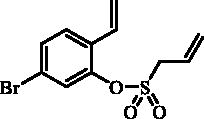 Compound 19 was prepared according to the general procedure from 5-bromo-2- ethenylphenol (18) (2.00 g; 10.05 mmol), prop-2-ene-1-sulphonyl chloride (4) (1.37 mL; 13.06 mmol) and NEt3 (1.96 mL; 14.07 mmol) as yellowish oil (1.65 g; 54%). IR (film, cm−1) νmax= 1377 (S = O), 1161 (S = O). 1H NMR (400 MHz, DMSO-d6) δ = 4.54 (dt, 2H, J = 7.2, 1.0 Hz), 5.48 (dd, 1H, J = 11.2, 0.8 Hz), 5.52–5.56 (m, 1H), 5.58–5.64 (m, 1H), 5.86–5.98 (m, 1H), 5.99 (dd, 1H, J = 17.6, 0.9 Hz), 6.89 (dd, 1H, J = 17.8, 11.2 Hz), 7.55–7.59 (m, 2H), 7.73–7.77 (m, 1H) ppm. 13 C NMR (100 MHz, DMSO-d6) δ = 55.1, 118.4, 120.8, 124.5, 125.4, 125.6, 128.1, 128.7, 130.3, 130.5, 146.1 ppm. HRMS (ESI) [M + H]+: m/z calcd for C11H12O3SBr: 302.9691. Found 302.9684.
Compound 19 was prepared according to the general procedure from 5-bromo-2- ethenylphenol (18) (2.00 g; 10.05 mmol), prop-2-ene-1-sulphonyl chloride (4) (1.37 mL; 13.06 mmol) and NEt3 (1.96 mL; 14.07 mmol) as yellowish oil (1.65 g; 54%). IR (film, cm−1) νmax= 1377 (S = O), 1161 (S = O). 1H NMR (400 MHz, DMSO-d6) δ = 4.54 (dt, 2H, J = 7.2, 1.0 Hz), 5.48 (dd, 1H, J = 11.2, 0.8 Hz), 5.52–5.56 (m, 1H), 5.58–5.64 (m, 1H), 5.86–5.98 (m, 1H), 5.99 (dd, 1H, J = 17.6, 0.9 Hz), 6.89 (dd, 1H, J = 17.8, 11.2 Hz), 7.55–7.59 (m, 2H), 7.73–7.77 (m, 1H) ppm. 13 C NMR (100 MHz, DMSO-d6) δ = 55.1, 118.4, 120.8, 124.5, 125.4, 125.6, 128.1, 128.7, 130.3, 130.5, 146.1 ppm. HRMS (ESI) [M + H]+: m/z calcd for C11H12O3SBr: 302.9691. Found 302.9684.
2-Bromo-6-vinylphenyl prop-2-ene-1-sulfonate (28)
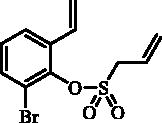 Compound 28 was prepared according to the general procedure from 2-bromo-6-ethenylphenol (27) (2.00 g; 10.05 mmol), prop-2-ene-1-sulphonyl chloride (4) (1.37 mL; 13.06 mmol) and NEt3 (1.96 mL; 14.07 mmol) as yellowish oil (2.62 g; 86%). IR (film, cm−1) νmax= 1367 (S = O), 1179 (S = O), 1165 (S = O). 1H NMR (400 MHz, CDCl3) δ = 4.31 (dt, 2H, J = 7.2, 1.0 Hz), 5.45 (dd, 1H, J = 11.0, 0.80 Hz), 5.57–5.65 (m, 2H), 5.81 (dd, 1H, J = 17.5, 0.8 Hz), 6.03–6.15 (m, 1H), 7.07–7.17 (m, 2H), 7.52–7.59 (m, 2H) ppm. 13 C NMR (100 MHz, CDCl3) δ = 57.9, 117.7, 118.4, 123.9, 125.7, 126.0, 128.3, 130.9, 133.1, 135.1, 144.4 ppm. HRMS (ESI) [M + H]+: m/z calcd for C11H12O3SBr: 302.9691. Found 302.9681.
Compound 28 was prepared according to the general procedure from 2-bromo-6-ethenylphenol (27) (2.00 g; 10.05 mmol), prop-2-ene-1-sulphonyl chloride (4) (1.37 mL; 13.06 mmol) and NEt3 (1.96 mL; 14.07 mmol) as yellowish oil (2.62 g; 86%). IR (film, cm−1) νmax= 1367 (S = O), 1179 (S = O), 1165 (S = O). 1H NMR (400 MHz, CDCl3) δ = 4.31 (dt, 2H, J = 7.2, 1.0 Hz), 5.45 (dd, 1H, J = 11.0, 0.80 Hz), 5.57–5.65 (m, 2H), 5.81 (dd, 1H, J = 17.5, 0.8 Hz), 6.03–6.15 (m, 1H), 7.07–7.17 (m, 2H), 7.52–7.59 (m, 2H) ppm. 13 C NMR (100 MHz, CDCl3) δ = 57.9, 117.7, 118.4, 123.9, 125.7, 126.0, 128.3, 130.9, 133.1, 135.1, 144.4 ppm. HRMS (ESI) [M + H]+: m/z calcd for C11H12O3SBr: 302.9691. Found 302.9681.
General method for 3H-1,2-benzoxathiepine 2,2-dioxide halogen derivative (7, 20, 29) synthesis
To a solution of corresponding diolefine (5, 15, 19, 28) (1.0 eq) in dry, degassed toluene (15 mL/1 mmol corresponding diolefine) ruthenium catalyst 6 (5 mol %) was added. Reaction mixture was bubbled with argon for 5 min and sealed, stirred at 70 °C for 4 h. After cooling to r.t. it was concentrated, and the crude product was purified by column chromatography on silica gel (EtOAc/PE 1:4). Products were re-crystallised from EtOH.
7-Iodo-3H-1,2-benzoxathiepine 2,2-dioxide (7)
 Compound 7 was prepared according to the general procedure from diolefine (5) (1.00 g; 2.86 mmol) and ruthenium catalyst 6 (0.14 g; 0.14 mmol) as yellowish solid (0.82 g; 89%). Mp 127–128 °C. IR (film, cm−1) νmax= 1370 (S = O), 1164 (S = O), 1155 (S = O). 1H NMR (400 MHz, DMSO-d6) δ = 4.52 (dd, 2H, J = 5.8, 1.3 Hz), 5.97–6.04 (m, 1H), 6.82–6.87 (m, 1H), 7.14 (d, 1H, J = 8.5 Hz), 7.79 (dd, 1H, J = 8.5, 2.2 Hz), 7.88 (d, 1H, J = 2.2 Hz) ppm. 13 C NMR (100 MHz, DMSO-d6) δ = 51.6, 92.3, 121.5, 124.5, 129.8, 130.4, 138.7, 139.6, 146.7 ppm. Anal. Calcd for C9H7IO3S: C, 33.56; H, 2.19. Found: C, 33.55; H, 2.21.
Compound 7 was prepared according to the general procedure from diolefine (5) (1.00 g; 2.86 mmol) and ruthenium catalyst 6 (0.14 g; 0.14 mmol) as yellowish solid (0.82 g; 89%). Mp 127–128 °C. IR (film, cm−1) νmax= 1370 (S = O), 1164 (S = O), 1155 (S = O). 1H NMR (400 MHz, DMSO-d6) δ = 4.52 (dd, 2H, J = 5.8, 1.3 Hz), 5.97–6.04 (m, 1H), 6.82–6.87 (m, 1H), 7.14 (d, 1H, J = 8.5 Hz), 7.79 (dd, 1H, J = 8.5, 2.2 Hz), 7.88 (d, 1H, J = 2.2 Hz) ppm. 13 C NMR (100 MHz, DMSO-d6) δ = 51.6, 92.3, 121.5, 124.5, 129.8, 130.4, 138.7, 139.6, 146.7 ppm. Anal. Calcd for C9H7IO3S: C, 33.56; H, 2.19. Found: C, 33.55; H, 2.21.
8-Bromo-3H-1,2-benzoxathiepine 2,2-dioxide (20)
 Compound 20 was prepared according to the general procedure from diolefine (19) (1.23 g; 4.06 mmol) and ruthenium catalyst 6 (0.19 g; 0.20 mmol) as white solid (1.0 g; 90%). Mp 144–145 °C. IR (film, cm−1) νmax= 1359 (S = O), 1182 (S = O), 1165 (S = O). 1H NMR (400 MHz, DMSO-d6) δ = 4.54 (dd, 2H, J = 5.8, 1.0 Hz), 5.95–6.05 (m, 1H), 6.87 (d, 1H, J = 11.4 Hz), 7.42–7.47 (m, 1H), 7.58–7.66 (m, 2H) ppm. 13 C NMR (100 MHz, DMSO-d6) δ = 51.9, 120.9, 122.0, 125.2, 127.5, 130.1, 130.3, 133.0, 147.1 ppm. Anal. Calcd for C9H7BrO3S: C, 39.29; H, 2.56. Found: C, 39.28; H, 2.59.
Compound 20 was prepared according to the general procedure from diolefine (19) (1.23 g; 4.06 mmol) and ruthenium catalyst 6 (0.19 g; 0.20 mmol) as white solid (1.0 g; 90%). Mp 144–145 °C. IR (film, cm−1) νmax= 1359 (S = O), 1182 (S = O), 1165 (S = O). 1H NMR (400 MHz, DMSO-d6) δ = 4.54 (dd, 2H, J = 5.8, 1.0 Hz), 5.95–6.05 (m, 1H), 6.87 (d, 1H, J = 11.4 Hz), 7.42–7.47 (m, 1H), 7.58–7.66 (m, 2H) ppm. 13 C NMR (100 MHz, DMSO-d6) δ = 51.9, 120.9, 122.0, 125.2, 127.5, 130.1, 130.3, 133.0, 147.1 ppm. Anal. Calcd for C9H7BrO3S: C, 39.29; H, 2.56. Found: C, 39.28; H, 2.59.
9-Bromo-3H-1,2-benzoxathiepine 2,2-dioxide (29)
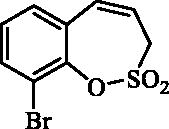 Compound 29 was prepared according to the general procedure from diolefine (28) (2.20 g; 7.26 mmol) and ruthenium catalyst 6 (0.34 g; 0.36 mmol) as yellowish solid (1.55 g; 78%). Mp 113–114 °C. IR (film, cm−1) νmax= 1364 (S = O), 1177 (S = O). 1H NMR (400 MHz, CDCl3) δ = 4.10 (dd, 2H, J = 6.0, 1.2 Hz), 5.95–6.03 (m, 1H), 6.82–6.87 (m, 1H), 7.18 (t, 1H, J = 7.8 Hz), 7.24–7.28 (m, 1H), 7.66 (dd, 1H, J = 7.9, 1.6 Hz) ppm. 13 C NMR (100 MHz, CDCl3) δ = 51.8, 117.7, 120.1, 128.0, 130.0, 130.1, 132.2, 134.2, 144.9 ppm. Anal. Calcd for C9H7BrO3S: C, 39.29; H, 2.56. Found: C, 39.28; H, 2.58.
Compound 29 was prepared according to the general procedure from diolefine (28) (2.20 g; 7.26 mmol) and ruthenium catalyst 6 (0.34 g; 0.36 mmol) as yellowish solid (1.55 g; 78%). Mp 113–114 °C. IR (film, cm−1) νmax= 1364 (S = O), 1177 (S = O). 1H NMR (400 MHz, CDCl3) δ = 4.10 (dd, 2H, J = 6.0, 1.2 Hz), 5.95–6.03 (m, 1H), 6.82–6.87 (m, 1H), 7.18 (t, 1H, J = 7.8 Hz), 7.24–7.28 (m, 1H), 7.66 (dd, 1H, J = 7.9, 1.6 Hz) ppm. 13 C NMR (100 MHz, CDCl3) δ = 51.8, 117.7, 120.1, 128.0, 130.0, 130.1, 132.2, 134.2, 144.9 ppm. Anal. Calcd for C9H7BrO3S: C, 39.29; H, 2.56. Found: C, 39.28; H, 2.58.
General method for 3H-1,2-benzoxathiepine 2,2-dioxide aril derivative (8–12, 21–25 and 30–34) synthesis
In a pressure tube corresponding 3H-1,2-benzoxathiepine 2,2-dioxide halogen derivative (7, 20, 29) (1.0 eq) was dissolved in dry toluene (6 mL/1 mmol corresponding 3H-1,2-benzoxathiepine 2,2-dioxide halogen derivative), degassed water was added (5% from toluene volume), corresponding boronic acid (1.5 eq), K3PO4 (2.0 eq) and Pd(PPh3)4 (0.1 eq). Reaction mixture was bubbled with argon 5 min, tube was sealed and heated for 16 h at 100 °C temperature. Reaction mixture was cooled to r.t., filtered through cellite was washed with EtOAc (40 mL). Mixture was evaporated and crude product was purified by column chromatography on silica gel (EtOAc/PE 1:3). Products were re-crystallised from EtOH.
7- Phenyl-3H-1,2-benzoxathiepine 2,2-dioxide (8)
 Compound 8 was prepared according to the general procedure from 7-iodo-3H-1,2-benzoxathiepine 2,2-dioxide (7) (0.20 g; 0.62 mmol) phenylboronic acid (0.11 g; 0.93 mmol), K3PO4 (0.26 g; 1.24 mmol) and Pd(PPh3)4 (72 mg; 0.062 mmol) as white solid (95 mg; 56%). Mp 144–145 C. IR (film, cm−1) νmax=1366 (S = O), 1363 (S = O), 1172 (S = O), 1164 (S = O). 1H NMR (400 MHz, CDCl3) δ = 4.06 (dd, 2H, J = 6.2, 0.8 Hz), 5.99–6.07 (m, 1H), 6.95 (d, 1H, J = 11.0 Hz), 7.38–7.43 (m, 2H), 7.44–7.52 (m, 3H), 7.54–7.58 (m, 2H), 7.62 (dd, 1H, J = 8.4, 2.2 Hz) ppm. 13 C NMR (100 MHz, CDCl3) δ = 51.4, 119.8, 123.3, 127.3, 128.1, 128.5, 129.1, 129.3, 129.4, 132.9, 139.4, 140.6, 147.1 ppm. Anal. Calcd for C15H12O3S: C, 66.16; H, 4.44.Found: C, 66.06; H, 4.45.
Compound 8 was prepared according to the general procedure from 7-iodo-3H-1,2-benzoxathiepine 2,2-dioxide (7) (0.20 g; 0.62 mmol) phenylboronic acid (0.11 g; 0.93 mmol), K3PO4 (0.26 g; 1.24 mmol) and Pd(PPh3)4 (72 mg; 0.062 mmol) as white solid (95 mg; 56%). Mp 144–145 C. IR (film, cm−1) νmax=1366 (S = O), 1363 (S = O), 1172 (S = O), 1164 (S = O). 1H NMR (400 MHz, CDCl3) δ = 4.06 (dd, 2H, J = 6.2, 0.8 Hz), 5.99–6.07 (m, 1H), 6.95 (d, 1H, J = 11.0 Hz), 7.38–7.43 (m, 2H), 7.44–7.52 (m, 3H), 7.54–7.58 (m, 2H), 7.62 (dd, 1H, J = 8.4, 2.2 Hz) ppm. 13 C NMR (100 MHz, CDCl3) δ = 51.4, 119.8, 123.3, 127.3, 128.1, 128.5, 129.1, 129.3, 129.4, 132.9, 139.4, 140.6, 147.1 ppm. Anal. Calcd for C15H12O3S: C, 66.16; H, 4.44.Found: C, 66.06; H, 4.45.
7–(4-Methoxyphenyl)-3H-1,2-benzoxathiepine 2,2-dioxide (9)
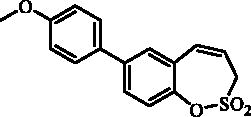 Compound 9 was prepared according to the general procedure from 7-iodo-3H-1,2-benzoxathiepine 2,2-dioxide (7) (0.20 g; 0.62 mmol) 4-methoxyphenylboronic acid (0.14 g; 0.93 mmol), K3PO4 (0.26 g; 1.24 mmol) and Pd(PPh3)4 (72 mg; 0.062 mmol) as yellowish solid (115 mg; 61%). Mp 162–163 C. IR (film, cm−1) νmax= 1395 (S = O), 1375 (S = O), 1179 (S = O), 1156 (S = O). 1H NMR (400 MHz, DMSO-d6) δ = 3.80 (s, 3H), 4.50 (dd, 2H, J = 5.8, 1.0 Hz), 5.98–6.06 (m, 1H), 6.97 (d, 1H, J = 11.2 Hz), 7.02–7.07 (m, 2H), 7.38 (d, 1H, J = 8.4 Hz), 7.62–7.67 (m, 2H), 7.69 (dd, 1H, J = 8.4, 2.4 Hz), 7.73 (d, 1H, J = 2.4 Hz) ppm. 13 C NMR (100 MHz, DMSO-d6) δ = 51.6, 55.2, 114.5, 120.5, 122.7, 127.9, 128.0, 128.4, 129.0, 130.8, 131.2, 138.7, 145.8, 159.3 ppm. Anal. Calcd for C16H14O4S: C, 63.56; H, 4.67. Found: C, 63.38; H, 4.68.
Compound 9 was prepared according to the general procedure from 7-iodo-3H-1,2-benzoxathiepine 2,2-dioxide (7) (0.20 g; 0.62 mmol) 4-methoxyphenylboronic acid (0.14 g; 0.93 mmol), K3PO4 (0.26 g; 1.24 mmol) and Pd(PPh3)4 (72 mg; 0.062 mmol) as yellowish solid (115 mg; 61%). Mp 162–163 C. IR (film, cm−1) νmax= 1395 (S = O), 1375 (S = O), 1179 (S = O), 1156 (S = O). 1H NMR (400 MHz, DMSO-d6) δ = 3.80 (s, 3H), 4.50 (dd, 2H, J = 5.8, 1.0 Hz), 5.98–6.06 (m, 1H), 6.97 (d, 1H, J = 11.2 Hz), 7.02–7.07 (m, 2H), 7.38 (d, 1H, J = 8.4 Hz), 7.62–7.67 (m, 2H), 7.69 (dd, 1H, J = 8.4, 2.4 Hz), 7.73 (d, 1H, J = 2.4 Hz) ppm. 13 C NMR (100 MHz, DMSO-d6) δ = 51.6, 55.2, 114.5, 120.5, 122.7, 127.9, 128.0, 128.4, 129.0, 130.8, 131.2, 138.7, 145.8, 159.3 ppm. Anal. Calcd for C16H14O4S: C, 63.56; H, 4.67. Found: C, 63.38; H, 4.68.
7–(4-Fluorophenyl)-3H-1,2-benzoxathiepine 2,2-dioxide (10)
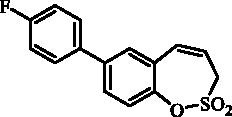 Compound 10 was prepared according to the general procedure from 7-iodo-3H-1,2-benzoxathiepine 2,2-dioxide (7) (0.20 g; 0.62 mmol) (4-fluorophenyl)boronic acid (0.13 g; 0.93 mmol), K3PO4 (0.26 g; 1.24 mmol) and Pd(PPh3)4 (72 mg; 0.062 mmol) as white solid (79 mg; 44%). Mp 117–118 °C. IR (film, cm−1) νmax=1373 (S = O), 1181 (S = O), 1168 (S = O). 1H NMR (400 MHz, CDCl3) δ = 4.06 (dd, 2H, J = 6.2, 1.2 Hz), 5.99–6.06 (m, 1H), 6.93 (d, 1H, J = 11.0 Hz), 7.12–7.18 (m, 2H), 7.39 (d, 1H, J = 8.4 Hz), 7.45 (d, 1H, J = 2.3 Hz), 7.49–7.55 (m, 2H), 7.57 (dd, 1H, J = 8.4, 2.3 Hz) ppm. 13 C NMR (100 MHz, CDCl3) δ = 51.4, 116.1 (d, J = 21.6 Hz), 119.9, 123.4, 128.6, 128.9, 129.0, 129.2, 129.3, 132.8, 135.6 (d, J = 3.4 Hz), 139.6, 147.1, 163.0 (d, J = 247.0 Hz) ppm. Anal. Calcd for C15H11FO3S: C, 62.06; H, 3.82. Found: C, 62.34; H, 3.83.
Compound 10 was prepared according to the general procedure from 7-iodo-3H-1,2-benzoxathiepine 2,2-dioxide (7) (0.20 g; 0.62 mmol) (4-fluorophenyl)boronic acid (0.13 g; 0.93 mmol), K3PO4 (0.26 g; 1.24 mmol) and Pd(PPh3)4 (72 mg; 0.062 mmol) as white solid (79 mg; 44%). Mp 117–118 °C. IR (film, cm−1) νmax=1373 (S = O), 1181 (S = O), 1168 (S = O). 1H NMR (400 MHz, CDCl3) δ = 4.06 (dd, 2H, J = 6.2, 1.2 Hz), 5.99–6.06 (m, 1H), 6.93 (d, 1H, J = 11.0 Hz), 7.12–7.18 (m, 2H), 7.39 (d, 1H, J = 8.4 Hz), 7.45 (d, 1H, J = 2.3 Hz), 7.49–7.55 (m, 2H), 7.57 (dd, 1H, J = 8.4, 2.3 Hz) ppm. 13 C NMR (100 MHz, CDCl3) δ = 51.4, 116.1 (d, J = 21.6 Hz), 119.9, 123.4, 128.6, 128.9, 129.0, 129.2, 129.3, 132.8, 135.6 (d, J = 3.4 Hz), 139.6, 147.1, 163.0 (d, J = 247.0 Hz) ppm. Anal. Calcd for C15H11FO3S: C, 62.06; H, 3.82. Found: C, 62.34; H, 3.83.
7–(4-(Trifluoromethyl)phenyl)-3H-1,2-benzoxathiepine 2,2-dioxide (11)
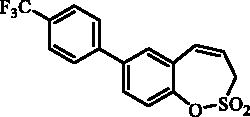 Compound 11 was prepared according to the general procedure from 7-iodo-3H-1,2-benzoxathiepine 2,2-dioxide (7) (0.20 g; 0.62 mmol) (4-(trifluoromethyl)phenyl)boronic acid (0.18 g; 0.93 mmol), K3PO4 (0.26 g; 1.24 mmol) and Pd(PPh3)4 (72 mg; 0.062 mmol) as white solid (140 mg; 66%). Mp 166–168 °C.
Compound 11 was prepared according to the general procedure from 7-iodo-3H-1,2-benzoxathiepine 2,2-dioxide (7) (0.20 g; 0.62 mmol) (4-(trifluoromethyl)phenyl)boronic acid (0.18 g; 0.93 mmol), K3PO4 (0.26 g; 1.24 mmol) and Pd(PPh3)4 (72 mg; 0.062 mmol) as white solid (140 mg; 66%). Mp 166–168 °C.
IR (film, cm−1) νmax=1357 (S = O), 1332 (S = O), 1166 (S = O). 1H NMR (400 MHz, DMSO-d6) δ = 4.56 (dd, 2H, J = 5.8, 1.0 Hz), 6.00–6.08 (m, 1H), 6.99 (d, 1H, J = 11.4 Hz), 7.47 (d, 1H, J = 8.4 Hz), 7.81–7.86 (m, 3H), 7.88 (d, 1H, J = 2.2 Hz), 7.94 (d, 2H, J = 8.2 Hz) ppm. 13 C NMR (100 MHz, DMSO-d6) δ = 51.8, 120.8, 123.0, 124.3 (q, J = 273.0 Hz), 125.9 (q, J = 3.7 Hz), 127.7, 128.3 (q, J = 32.0 Hz), 128.6, 128.9, 130.3, 130.8, 137.4, 142.5, 146.9 ppm. Anal. Calcd for C16H11F3O3S: C, 56.47; H, 3.26. Found: C, 56.46; H, 3.28.
7–(4-(Ethoxycarbonyl)phenyl)-3H-1,2-benzoxathiepine 2,2-dioxide (12)
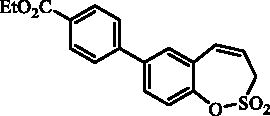 Compound 12 was prepared according to the general procedure from 7-iodo-3H-1,2-benzoxathiepine 2,2-dioxide (7) (0.20 g; 0.62 mmol) (4-(ethoxycarbonyl)phenyl)boronic acid (0.18 g; 0.93 mmol), K3PO4 (0.26 g; 1.24 mmol) and Pd(PPh3)4 (72 mg; 0.062 mmol) as yellowish solid (96 mg; 44%). Mp 141–142 °C. IR (film, cm−1) νmax= 1701 (C = O), 1380 (S = O), 1184 (S = O), 1170 (S = O). 1H NMR (400 MHz, DMSO-d6) δ = 1.34 (t, 3H, J = 7.1 Hz), 4.34 (q, 2H, J = 7.1 Hz), 4.55 (dd, 2H, J = 5.8, 1.2 Hz), 6.00–6.08 (m, 1H), 6.99 (d, 1H, J = 11.5 Hz), 7.46 (d, 1H, J = 8.5 Hz), 7.83 (dd, 1H, J = 8.5, 2.3 Hz), 7.85–7.90 (m, 3H), 8.03–8.08 (m, 2H) ppm. 13 C NMR (100 MHz, DMSO-d6) δ = 14.2, 51.7, 60.8, 120.8, 123.0, 127.1, 128.6, 128.8, 129.2, 129.8, 130.1, 130.8, 137.7, 142.9, 146.9, 165.4 ppm. Anal. Calcd for C18H16O5S: C, 62.78; H, 4.68. Found: C, 62.76; H, 4.71.
Compound 12 was prepared according to the general procedure from 7-iodo-3H-1,2-benzoxathiepine 2,2-dioxide (7) (0.20 g; 0.62 mmol) (4-(ethoxycarbonyl)phenyl)boronic acid (0.18 g; 0.93 mmol), K3PO4 (0.26 g; 1.24 mmol) and Pd(PPh3)4 (72 mg; 0.062 mmol) as yellowish solid (96 mg; 44%). Mp 141–142 °C. IR (film, cm−1) νmax= 1701 (C = O), 1380 (S = O), 1184 (S = O), 1170 (S = O). 1H NMR (400 MHz, DMSO-d6) δ = 1.34 (t, 3H, J = 7.1 Hz), 4.34 (q, 2H, J = 7.1 Hz), 4.55 (dd, 2H, J = 5.8, 1.2 Hz), 6.00–6.08 (m, 1H), 6.99 (d, 1H, J = 11.5 Hz), 7.46 (d, 1H, J = 8.5 Hz), 7.83 (dd, 1H, J = 8.5, 2.3 Hz), 7.85–7.90 (m, 3H), 8.03–8.08 (m, 2H) ppm. 13 C NMR (100 MHz, DMSO-d6) δ = 14.2, 51.7, 60.8, 120.8, 123.0, 127.1, 128.6, 128.8, 129.2, 129.8, 130.1, 130.8, 137.7, 142.9, 146.9, 165.4 ppm. Anal. Calcd for C18H16O5S: C, 62.78; H, 4.68. Found: C, 62.76; H, 4.71.
8-Phenyl-3H-1,2-benzoxathiepine 2,2-dioxide (21)
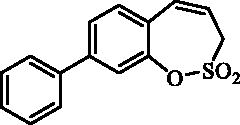 Compound 21 was prepared according to the general procedure from 8-bromo-3H-1,2-benzoxathiepine 2,2-dioxide (20) (0.25 g; 0.91 mmol) phenylboronic acid (0.17 g; 1.36 mmol), K3PO4 (0.39 g; 1.82 mmol) and Pd(PPh3)4 (105 mg; 0.091 mmol) as yellowish solid (109 mg; 44%). Mp 103–104 °C. IR (film, cm−1) νmax= 1376 (S = O), 1177 (S = O). 1H NMR (400 MHz, CDCl3) δ = 4.08 (dd, 2H, J = 6.1, 1.2 Hz), 5.94–6.01 (m, 1H), 6.88–6.93 (m, 1H), 7.36–7.43 (m, 2H), 7.44–7.50 (m, 2H), 7.55–7.63 (m, 4H) ppm. 13 C KMR (100 MHz, CDCl3) δ = 51.6, 119.2, 121.3, 125.7, 126.8, 127.2, 128.5, 129.2, 131.3, 132.5, 138.9, 144.0, 148.1 ppm. Anal. Calcd for C15H12O3S: C, 66.16; H, 4.44. Found: C, 66.15; H, 4.46.
Compound 21 was prepared according to the general procedure from 8-bromo-3H-1,2-benzoxathiepine 2,2-dioxide (20) (0.25 g; 0.91 mmol) phenylboronic acid (0.17 g; 1.36 mmol), K3PO4 (0.39 g; 1.82 mmol) and Pd(PPh3)4 (105 mg; 0.091 mmol) as yellowish solid (109 mg; 44%). Mp 103–104 °C. IR (film, cm−1) νmax= 1376 (S = O), 1177 (S = O). 1H NMR (400 MHz, CDCl3) δ = 4.08 (dd, 2H, J = 6.1, 1.2 Hz), 5.94–6.01 (m, 1H), 6.88–6.93 (m, 1H), 7.36–7.43 (m, 2H), 7.44–7.50 (m, 2H), 7.55–7.63 (m, 4H) ppm. 13 C KMR (100 MHz, CDCl3) δ = 51.6, 119.2, 121.3, 125.7, 126.8, 127.2, 128.5, 129.2, 131.3, 132.5, 138.9, 144.0, 148.1 ppm. Anal. Calcd for C15H12O3S: C, 66.16; H, 4.44. Found: C, 66.15; H, 4.46.
8–(4-Methoxyphenyl)-3H-1,2-benzoxathiepine 2,2-dioxide (22)
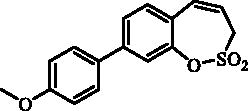 Compound 22 was prepared according to the general procedure from 8-bromo-3H-1,2-benzoxathiepine 2,2-dioxide (20) (0.25 g; 0.91 mmol) 4-methoxyphenylboronic acid (0.21 g; 1.36 mmol), K3PO4 (0.39 g; 1.82 mmol) and Pd(PPh3)4 (105 mg; 0.091 mmol) as yellowish solid (121 mg; 44%). Mp 142–143 °C. IR (film, cm−1) νmax= 1369 (S = O), 1177 (S = O), 1164 (S = O). 1H NMR (400 MHz, CDCl3) δ = 3.86 (s, 3H), 4.07 (dd, 2H, J = 6.1, 1.1 Hz), 5.92–5.99 (m, 1H), 6.88 (d, 1H, J = 11.1 Hz), 6.97–7.02 (m, 2H), 7.32–7.36 (m, 1H), 7.50–7.58 (m, 4H) ppm. 13 C NMR (100 MHz, CDCl3) δ = 51.6, 55.5, 114.6, 118.8, 120.6, 125.2, 126.1, 128.3, 131.3, 132.6, 143.6, 148.2, 160.1 ppm. Anal. Calcd for C16H14O4S: C, 63.56; H, 4.67. Found: C, 63.20; H, 4.69.
Compound 22 was prepared according to the general procedure from 8-bromo-3H-1,2-benzoxathiepine 2,2-dioxide (20) (0.25 g; 0.91 mmol) 4-methoxyphenylboronic acid (0.21 g; 1.36 mmol), K3PO4 (0.39 g; 1.82 mmol) and Pd(PPh3)4 (105 mg; 0.091 mmol) as yellowish solid (121 mg; 44%). Mp 142–143 °C. IR (film, cm−1) νmax= 1369 (S = O), 1177 (S = O), 1164 (S = O). 1H NMR (400 MHz, CDCl3) δ = 3.86 (s, 3H), 4.07 (dd, 2H, J = 6.1, 1.1 Hz), 5.92–5.99 (m, 1H), 6.88 (d, 1H, J = 11.1 Hz), 6.97–7.02 (m, 2H), 7.32–7.36 (m, 1H), 7.50–7.58 (m, 4H) ppm. 13 C NMR (100 MHz, CDCl3) δ = 51.6, 55.5, 114.6, 118.8, 120.6, 125.2, 126.1, 128.3, 131.3, 132.6, 143.6, 148.2, 160.1 ppm. Anal. Calcd for C16H14O4S: C, 63.56; H, 4.67. Found: C, 63.20; H, 4.69.
8–(4-Fluorophenyl)-3H-1,2-benzoxathiepine 2,2-dioxide (23)
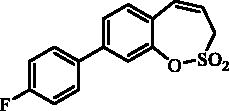 Compound 23 was prepared according to the general procedure from 8-bromo-3H-1,2-benzoxathiepine 2,2-dioxide (20) (0.25 g; 0.91 mmol) (4-fluorophenyl)boronic acid (0.19 g; 1.36 mmol), K3PO4 (0.39 g; 1.82 mmol) and Pd(PPh3)4 (105 mg; 0.091 mmol) as white solid (108 mg; 41%). Mp 111–112 °C. IR (film, cm−1) νmax= 1371 (S = O), 1168 (S = O). 1H NMR (400 MHz, CDCl3) δ = 4.08 (dd, 2H, J = 6.1, 1.2 Hz), 5.94–6.01 (m, 1H), 6.90 (d, 1H, J = 11.0 Hz), 7.12–7.19 (m, 2H), 7.35–7.40 (m, 1H), 7.50–7.53 (m, 2H), 7.54–7.60 (m, 2H) ppm. 13 C NMR (100 MHz, CDCl3) δ = 51.7, 116.2 (d, J = 21.6 Hz), 119.3, 121.2, 125.6, 126.9, 128.9, 129.0, 131.5, 132.4, 135.0 (d, J = 3.3 Hz), 142.9, 148.1, 163.2 (d, J = 248.0 Hz) ppm. Anal. Calcd for C15H11FO3S: C, 62.06; H, 3.82. Found: C, 62.04; H, 3.86.
Compound 23 was prepared according to the general procedure from 8-bromo-3H-1,2-benzoxathiepine 2,2-dioxide (20) (0.25 g; 0.91 mmol) (4-fluorophenyl)boronic acid (0.19 g; 1.36 mmol), K3PO4 (0.39 g; 1.82 mmol) and Pd(PPh3)4 (105 mg; 0.091 mmol) as white solid (108 mg; 41%). Mp 111–112 °C. IR (film, cm−1) νmax= 1371 (S = O), 1168 (S = O). 1H NMR (400 MHz, CDCl3) δ = 4.08 (dd, 2H, J = 6.1, 1.2 Hz), 5.94–6.01 (m, 1H), 6.90 (d, 1H, J = 11.0 Hz), 7.12–7.19 (m, 2H), 7.35–7.40 (m, 1H), 7.50–7.53 (m, 2H), 7.54–7.60 (m, 2H) ppm. 13 C NMR (100 MHz, CDCl3) δ = 51.7, 116.2 (d, J = 21.6 Hz), 119.3, 121.2, 125.6, 126.9, 128.9, 129.0, 131.5, 132.4, 135.0 (d, J = 3.3 Hz), 142.9, 148.1, 163.2 (d, J = 248.0 Hz) ppm. Anal. Calcd for C15H11FO3S: C, 62.06; H, 3.82. Found: C, 62.04; H, 3.86.
8–(4-(Trifluoromethyl)phenyl)-3H-1,2-benzoxathiepine 2,2-dioxide (24)
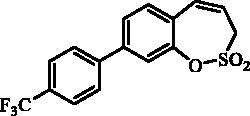 Compound 24 was prepared according to the general procedure from 8-bromo-3H-1,2-benzoxathiepine 2,2-dioxide (20) (0.25 g; 0.91 mmol) (4-(trifluoromethyl)phenyl)boronic acid (0.26 g; 1.36 mmol), K3PO4 (0.39 g; 1.82 mmol) and Pd(PPh3)4 (105 mg; 0.091 mmol) as white solid (142 mg; 46%). Mp 121–122 °C. IR (film, cm−1) νmax= 1366 (S = O), 1324 (S = O), 1172 (S = O). 1H NMR (400 MHz, CDCl3) δ = 4.11 (dd, 2H, J = 6.1, 1.2 Hz), 5.97–6.04 (m, 1H), 6.90 (d, 1H, J = 11.2 Hz), 7.40–7.44 (m, 1H), 7.55–7.60 (m, 2H), 7.70–7.75 (m, 4H) ppm. 13 C NMR (100 MHz, CDCl3) δ = 51.8, 119.7, 121.6, 124.2 (q, J = 273.0 Hz), 125.9, 126.2 (q, J = 3.8 Hz), 127.6, 127.8, 130.5 (q, J = 32.9 Hz), 131.7, 132.2, 142.3, 142.4, 148.1 ppm. Anal. Calcd for C16H11F3O3S: C, 56.47; H, 3.26. Found: C, 56.23; H, 3.23.
Compound 24 was prepared according to the general procedure from 8-bromo-3H-1,2-benzoxathiepine 2,2-dioxide (20) (0.25 g; 0.91 mmol) (4-(trifluoromethyl)phenyl)boronic acid (0.26 g; 1.36 mmol), K3PO4 (0.39 g; 1.82 mmol) and Pd(PPh3)4 (105 mg; 0.091 mmol) as white solid (142 mg; 46%). Mp 121–122 °C. IR (film, cm−1) νmax= 1366 (S = O), 1324 (S = O), 1172 (S = O). 1H NMR (400 MHz, CDCl3) δ = 4.11 (dd, 2H, J = 6.1, 1.2 Hz), 5.97–6.04 (m, 1H), 6.90 (d, 1H, J = 11.2 Hz), 7.40–7.44 (m, 1H), 7.55–7.60 (m, 2H), 7.70–7.75 (m, 4H) ppm. 13 C NMR (100 MHz, CDCl3) δ = 51.8, 119.7, 121.6, 124.2 (q, J = 273.0 Hz), 125.9, 126.2 (q, J = 3.8 Hz), 127.6, 127.8, 130.5 (q, J = 32.9 Hz), 131.7, 132.2, 142.3, 142.4, 148.1 ppm. Anal. Calcd for C16H11F3O3S: C, 56.47; H, 3.26. Found: C, 56.23; H, 3.23.
8–(4-(Ethoxycarbonyl)phenyl)-3H-1,2-benzoxathiepine 2,2-dioxide (25)
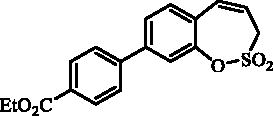 Compound 25 was prepared according to the general procedure from 8-bromo-3H-1,2-benzoxathiepine 2,2-dioxide (20) (0.25 g; 0.91 mmol) (4-(ethoxycarbonyl)phenyl)boronic acid (0.26 g; 1.36 mmol), K3PO4 (0.39 g; 1.82 mmol) and Pd(PPh3)4 (105 mg; 0.091 mmol) as white solid (119 mg; 38%). Mp 151–152 °C. IR (film, cm−1) νmax= 1703 (C = O), 1366 (S = O), 1175 (S = O). 1H NMR (400 MHz, CDCl3) δ = 1.42 (t, 3H, J = 7.1 Hz), 4.10 (dd, 2H, J = 6.1, 1.2 Hz), 4.41 (q, 2H, J = 7.1 Hz), 5.96–6.03 (m, 1H), 6.90 (d, 1H, J = 11.2 Hz), 7.39–7.43 (m, 1H), 7.57–7.62 (m, 2H), 7.65–7.70 (m, 2H), 8.11–8.16 (m, 2H) ppm. 13 C NMR (100 MHz, CDCl3) δ = 14.5, 51.7, 61.3, 119.6, 121.5, 125.9, 127.1, 127.7, 130.4, 131.6, 132.3, 142.7, 143.0, 148.1, 166.3 ppm. Anal. Calcd for C18H16O5S: C, 62.78; H, 4.68. Found: C, 62.50; H, 4.70.
Compound 25 was prepared according to the general procedure from 8-bromo-3H-1,2-benzoxathiepine 2,2-dioxide (20) (0.25 g; 0.91 mmol) (4-(ethoxycarbonyl)phenyl)boronic acid (0.26 g; 1.36 mmol), K3PO4 (0.39 g; 1.82 mmol) and Pd(PPh3)4 (105 mg; 0.091 mmol) as white solid (119 mg; 38%). Mp 151–152 °C. IR (film, cm−1) νmax= 1703 (C = O), 1366 (S = O), 1175 (S = O). 1H NMR (400 MHz, CDCl3) δ = 1.42 (t, 3H, J = 7.1 Hz), 4.10 (dd, 2H, J = 6.1, 1.2 Hz), 4.41 (q, 2H, J = 7.1 Hz), 5.96–6.03 (m, 1H), 6.90 (d, 1H, J = 11.2 Hz), 7.39–7.43 (m, 1H), 7.57–7.62 (m, 2H), 7.65–7.70 (m, 2H), 8.11–8.16 (m, 2H) ppm. 13 C NMR (100 MHz, CDCl3) δ = 14.5, 51.7, 61.3, 119.6, 121.5, 125.9, 127.1, 127.7, 130.4, 131.6, 132.3, 142.7, 143.0, 148.1, 166.3 ppm. Anal. Calcd for C18H16O5S: C, 62.78; H, 4.68. Found: C, 62.50; H, 4.70.
9- Phenyl-3H-1,2-benzoxathiepine 2,2-dioxide (30)
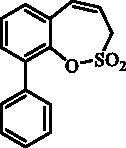 Compound 30 was prepared according to the general procedure from 9-bromo-3H-1,2-benzoxathiepine 2,2-dioxide (29) (0.25 g; 0.91 mmol) phenylboronic acid (0.17 g; 1.36 mmol), K3PO4 (0.39 g; 1.82 mmol) and Pd(PPh3)4 (105 mg; 0.091 mmol) as white solid (104 mg; 42%). Mp 135–136 °C. IR (film, cm−1) νmax= 1370 (S = O), 1162 (S = O). 1H NMR (400 MHz, CDCl3) δ = 4.08 (dd, 2H, J = 5.8, 1.3 Hz), 5.87–5.94 (m, 1H), 6.85–6.90 (m, 1H), 7.29 (dd, 1H, J = 7.6, 1.8 Hz), 7.35–7.42 (m, 2H), 7.43–7.49 (m, 3H), 7.51–7.55 (m, 2H) ppm. 13 C KMR (100 MHz, CDCl3) δ = 52.1, 118.9, 127.1, 128.1, 128.5, 128.6, 129.6, 130.5, 132.1, 132.5, 136.3, 136.5, 144.7 ppm. Anal. Calcd for C15H12O3S: C, 66.16; H, 4.44. Found: C, 66.15; H, 4.46.
Compound 30 was prepared according to the general procedure from 9-bromo-3H-1,2-benzoxathiepine 2,2-dioxide (29) (0.25 g; 0.91 mmol) phenylboronic acid (0.17 g; 1.36 mmol), K3PO4 (0.39 g; 1.82 mmol) and Pd(PPh3)4 (105 mg; 0.091 mmol) as white solid (104 mg; 42%). Mp 135–136 °C. IR (film, cm−1) νmax= 1370 (S = O), 1162 (S = O). 1H NMR (400 MHz, CDCl3) δ = 4.08 (dd, 2H, J = 5.8, 1.3 Hz), 5.87–5.94 (m, 1H), 6.85–6.90 (m, 1H), 7.29 (dd, 1H, J = 7.6, 1.8 Hz), 7.35–7.42 (m, 2H), 7.43–7.49 (m, 3H), 7.51–7.55 (m, 2H) ppm. 13 C KMR (100 MHz, CDCl3) δ = 52.1, 118.9, 127.1, 128.1, 128.5, 128.6, 129.6, 130.5, 132.1, 132.5, 136.3, 136.5, 144.7 ppm. Anal. Calcd for C15H12O3S: C, 66.16; H, 4.44. Found: C, 66.15; H, 4.46.
9–(4-Methoxyphenyl)-3H-1,2-benzoxathiepine 2,2-dioxide (31)
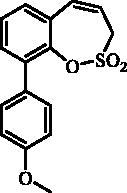 Compound 31 was prepared according to the general procedure from 9-bromo-3H-1,2-benzoxathiepine 2,2-dioxide (29) (0.25 g; 0.91 mmol) 4-methoxyphenylboronic acid (0.21 g; 1.36 mmol), K3PO4 (0.39 g; 1.82 mmol) and Pd(PPh3)4 (105 mg; 0.091 mmol) as white solid (110 mg; 40%). Mp 113–114 °C. IR (film, cm−1) νmax= 1369 (S = O), 1181 (S = O), 1154 (S = O). 1H NMR (400 MHz, CDCl3) δ = 3.85 (s, 3H), 4.08 (dd, 2H, J = 5.8, 1.3 Hz), 5.86–5.94 (m, 1H), 6.84–6.89 (m, 1H), 6.97–7.02 (m, 2H), 7.23–7.27 (m, 1H), 7.34 (t, 1H, J = 7.6 Hz), 7.42 (dd, 1H, J = 7.6, 1.8 Hz), 7.45–7.50 (m, 2H) ppm. 13 C NMR (100 MHz, CDCl3) δ = 52.0, 55.4, 114.0, 118.9, 127.1, 128.6, 128.7, 130.1, 130.8, 132.0, 132.6, 136.2, 144.7, 159.5 ppm. Anal. Calcd for C16H14O4S: C, 63.56; H, 4.67. Found: C, 63.58; H, 4.70.
Compound 31 was prepared according to the general procedure from 9-bromo-3H-1,2-benzoxathiepine 2,2-dioxide (29) (0.25 g; 0.91 mmol) 4-methoxyphenylboronic acid (0.21 g; 1.36 mmol), K3PO4 (0.39 g; 1.82 mmol) and Pd(PPh3)4 (105 mg; 0.091 mmol) as white solid (110 mg; 40%). Mp 113–114 °C. IR (film, cm−1) νmax= 1369 (S = O), 1181 (S = O), 1154 (S = O). 1H NMR (400 MHz, CDCl3) δ = 3.85 (s, 3H), 4.08 (dd, 2H, J = 5.8, 1.3 Hz), 5.86–5.94 (m, 1H), 6.84–6.89 (m, 1H), 6.97–7.02 (m, 2H), 7.23–7.27 (m, 1H), 7.34 (t, 1H, J = 7.6 Hz), 7.42 (dd, 1H, J = 7.6, 1.8 Hz), 7.45–7.50 (m, 2H) ppm. 13 C NMR (100 MHz, CDCl3) δ = 52.0, 55.4, 114.0, 118.9, 127.1, 128.6, 128.7, 130.1, 130.8, 132.0, 132.6, 136.2, 144.7, 159.5 ppm. Anal. Calcd for C16H14O4S: C, 63.56; H, 4.67. Found: C, 63.58; H, 4.70.
9–(4-Fluorophenyl)-3H-1,2-benzoxathiepine 2,2-dioxide (32)
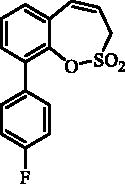 Compound 32 was prepared according to the general procedure from 9-bromo-3H-1,2-benzoxathiepine 2,2-dioxide (29) (0.25 g; 0.91 mmol) (4-fluorophenyl)boronic acid (0.19 g; 1.36 mmol), K3PO4 (0.39 g; 1.82 mmol) and Pd(PPh3)4 (105 mg; 0.091 mmol) as white solid (103 mg; 39%). Mp 130–131 °C. IR (film, cm−1) νmax=1370 (S = O), 1154 (S = O). 1H NMR (400 MHz, CDCl3) δ = 4.08 (dd, 2H, J = 5.8, 1.3 Hz), 5.88–5.95 (m, 1H), 6.85–6.90 (m, 1H), 7.10–7.18 (m, 2H), 7.30 (dd, 1H, J = 7.5, 2.0 Hz), 7.37 (t, 1H, J = 7.5 Hz), 7.41 (dd, 1H, J = 7.5, 2.0 Hz), 7.47–7.53 (m, 2H) ppm. 13 C NMR (100 MHz, CDCl3) δ = 52.1, 115.5 (d, J = 21.6 Hz), 119.1, 127.2, 128.7, 130.6, 131.3, 131.4, 132.0, 132.3 (d, J = 3.3 Hz), 132.5, 135.6, 144.7, 162.8 (d, J = 247.0 Hz) ppm. Anal. Calcd for C15H11FO3S: C, 62.06; H, 3.82. Found: C, 62.05; H, 3.84.
Compound 32 was prepared according to the general procedure from 9-bromo-3H-1,2-benzoxathiepine 2,2-dioxide (29) (0.25 g; 0.91 mmol) (4-fluorophenyl)boronic acid (0.19 g; 1.36 mmol), K3PO4 (0.39 g; 1.82 mmol) and Pd(PPh3)4 (105 mg; 0.091 mmol) as white solid (103 mg; 39%). Mp 130–131 °C. IR (film, cm−1) νmax=1370 (S = O), 1154 (S = O). 1H NMR (400 MHz, CDCl3) δ = 4.08 (dd, 2H, J = 5.8, 1.3 Hz), 5.88–5.95 (m, 1H), 6.85–6.90 (m, 1H), 7.10–7.18 (m, 2H), 7.30 (dd, 1H, J = 7.5, 2.0 Hz), 7.37 (t, 1H, J = 7.5 Hz), 7.41 (dd, 1H, J = 7.5, 2.0 Hz), 7.47–7.53 (m, 2H) ppm. 13 C NMR (100 MHz, CDCl3) δ = 52.1, 115.5 (d, J = 21.6 Hz), 119.1, 127.2, 128.7, 130.6, 131.3, 131.4, 132.0, 132.3 (d, J = 3.3 Hz), 132.5, 135.6, 144.7, 162.8 (d, J = 247.0 Hz) ppm. Anal. Calcd for C15H11FO3S: C, 62.06; H, 3.82. Found: C, 62.05; H, 3.84.
9–(4-(Trifluoromethyl)phenyl)-3H-1,2-benzoxathiepine 2,2-dioxide (33)
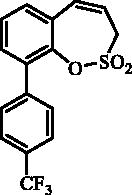 Compound 33 was prepared according to the general procedure from 9-bromo-3H-1,2-benzoxathiepine 2,2-dioxide (29) (0.25 g; 0.91 mmol) (4-(trifluoromethyl)phenyl)boronic acid (0.26 g; 1.36 mmol), K3PO4 (0.39 g; 1.82 mmol) and Pd(PPh3)4 (105 mg; 0.091 mmol) as white solid (136 mg; 44%). Mp 115–116 °C.
Compound 33 was prepared according to the general procedure from 9-bromo-3H-1,2-benzoxathiepine 2,2-dioxide (29) (0.25 g; 0.91 mmol) (4-(trifluoromethyl)phenyl)boronic acid (0.26 g; 1.36 mmol), K3PO4 (0.39 g; 1.82 mmol) and Pd(PPh3)4 (105 mg; 0.091 mmol) as white solid (136 mg; 44%). Mp 115–116 °C.
IR (film, cm−1) νmax= 1333 (S = O), 1166 (S = O). 1H NMR (400 MHz, CDCl3) δ = 4.10 (dd, 2H, J = 5.8, 1.3 Hz), 5.90–5.97 (m, 1H), 6.86–6.91 (m, 1H), 7.35 (dd, 1H, J = 7.0, 2.6 Hz), 7.38–7.45 (m, 2H), 7.62–7.67 (m, 2H), 7.70–7.74 (m, 2H) ppm. 13 C NMR (100 MHz, CDCl3) δ = 52.2, 119.2, 124.5 (q, J = 273.0 Hz), 125.5 (q, J = 3.8 Hz), 127.3, 128.9, 130.0, 130.2 (q, J = 32.0 Hz), 131.3, 131.9, 132.3, 135.2, 140.0 (q, J = 1.5 Hz), 144.6 ppm. Anal. Calcd for C16H11F3O3S: C, 56.47; H, 3.26. Found: C, 56.21; H, 3.29.
9–(4-(Ethoxycarbonyl)phenyl)-3H-1,2-benzoxathiepine 2,2-dioxide (34)
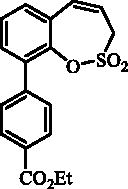 Compound 34 was prepared according to the general procedure from 9-bromo-3H-1,2-benzoxathiepine 2,2-dioxide (29) (0.25 g; 0.91 mmol) (4-(ethoxycarbonyl)phenyl)boronic acid (0.26 g; 1.36 mmol), K3PO4 (0.39 g; 1.82 mmol) and Pd(PPh3)4 (105 mg; 0.091 mmol) as white solid (113 mg; 36%). Mp 105–106 °C.
Compound 34 was prepared according to the general procedure from 9-bromo-3H-1,2-benzoxathiepine 2,2-dioxide (29) (0.25 g; 0.91 mmol) (4-(ethoxycarbonyl)phenyl)boronic acid (0.26 g; 1.36 mmol), K3PO4 (0.39 g; 1.82 mmol) and Pd(PPh3)4 (105 mg; 0.091 mmol) as white solid (113 mg; 36%). Mp 105–106 °C.
IR (film, cm−1) νmax= 1714 (C = O), 1375 (S = O), 1157 (S = O). 1H NMR (400 MHz, CDCl3) δ = 1.41 (t, 3H, J = 7.1 Hz), 4.08 (dd, 2H, J = 5.8, 1.1 Hz), 4.40 (q, 2H, J = 7.1 Hz), 5.89–5.97 (m, 1H), 6.88 (d, 1H, J = 11.4 Hz), 7.31–7.46 (m, 3H), 7.58–7.63 (m, 2H), 8.11–8.16 (m, 2H) ppm. 13 C NMR (100 MHz, CDCl3) δ = 14.5, 52.1, 61.1, 119.2, 127.2, 128.8, 129.6, 129.7, 130.1, 131.1, 131.8, 132.4, 135.6, 140.9, 144.6, 166.5 ppm. Anal. Calcd for C18H16O5S: C, 62.78; H, 4.68. Found: C, 62.28; H, 4.69.
2.2. CA inhibitory assay
An Applied Photophysics stopped-flow instrument has been used for assaying the CA catalysed CO2 hydration activityCitation15. Phenol red (at a concentration of 0.2 mM) was used as indicator, working at the absorbance maximum of 557 nm, with 20 mM Hepes (pH 7.5) as buffer and 20 mM Na2SO4 (for maintaining constant the ionic strength), following the initial rates of the CA-catalysed CO2 hydration reaction for a period of 10 − 100 s. The CO2 concentrations ranged from 1.7 to 17 mM for the determination of the kinetic parameters and inhibition constants. For each inhibitor, at least six traces of the initial 5 − 10% of the reaction have been used for determining the initial velocity. The uncatalysed rates were determined in the same manner and subtracted from the total observed rates. Stock solutions of inhibitor (0.1 mM) were prepared in distilled − deionised water, and dilutions up to 0.01 nM were done thereafter with the assay buffer. Inhibitor and enzyme solutions were preincubated together for 6 h at room temperature prior to assay in order to allow for the formation of the E − I complex. The inhibition constants were obtained by nonlinear least-squares methods using PRISM 3 and the Cheng − Prusoff equation, as reported earlierCitation16–19, and represent the mean from at least three different determinations. All CA isoforms were recombinant ones obtained in-house as reported earlierCitation19,Citation20.
3. Results and discussion
3.1. Chemistry
The synthesis of desired compounds is partly based on the strategy previously developed by our groupsCitation10. The synthesis of 7-aryl 3H-1,2-benzoxathiepine 2,2-dioxides starts with the iodination of salicylaldehyde (1) by iodine monochloride and corresponding iodo derivative 2 was isolated in good yield (Scheme 1)Citation11. Under Wittig reaction conditions aldehyde 2 was converted to olefin 3, which was treated by sulphonyl chloride 4 thus providing bis-olefin 5 in 83% yield. To obtain the key intermediate 7, the ring closure in compound 5 was performed in olefin metathesis conditions, using Ru-catalyst 6. The key intermediate 7 was reacted with a series of aryl boronic acids under Suzuki reaction conditions and the desired 7-aryl 3H-1,2-benzoxathiepine 2,2-dioxides 8–12 were isolated in acceptable yields (44–66%) (Scheme 1).
Scheme 1. Reagents and conditions for the preparation of derivatives 8–12: (i) ICl, AcOH, 40 °C, 24 h, 84%; (ii) KOtBu, CH3P(C6H5)3Br, THF, RT, 18 h, 83%; (iii) NEt3, CH2Cl2, 0 °C to RT, 4 h, 83%; (iv) toluene, 70 °C, 4 h, 89%; (v) Ar-B(OH)2, Pd(PPh3)4, K3PO4, toluene/H2O, 100 °C, 16 h.

In an attempt to prepare 6-aryl 3H-1,2-benzoxathiepine 2,2-dioxides, the commercially available bromo salicylaldehyde 13 was first converted to olefin 14 under Wittig reaction conditions, followed by treatment with sulphonyl chloride 4, thus providing bis-olefin 15 for olefin metathesis ring closure reaction (Scheme 2). Utilisation of the Ru-catalyst 6 as described above did not provide the formation of the desired key intermediate 6-bromo 3H-1,2-benzoxathiepine 2,2-dioxide (16) even at prolonged reaction times. By doubling catalyst 6 amount (10 mol%) only traces of compound 16 were observed after 40 h. No product formation was observed also when using Schrock and Schrock–Hoveyda Mo-catalysts. Probably olefin metathesis ring closure reaction did not take place due to sterical constraints due to the bulky Br atom at 3-positon of bis-olefin 15.
Scheme 2. Reagents and conditions: (i) KOtBu, CH3P(C6H5)3Br, THF, RT, 18 h, 82%; (ii) 4, NEt3, CH2Cl2, 0 °C to RT, 4 h, 66%; (iii) a) 6 (5 mol% and 10 mol%), toluene, 70 °C, 40 h, 0%; b) Schrock catalyst [Mo] (10 mol%), toluene, 70 °C, 16 h, 0%; c) Schrock–Hoveyda [Mo] (10 mol%), toluene, 70 °C, 16 h, 0%;
![Scheme 2. Reagents and conditions: (i) KOtBu, CH3P(C6H5)3Br, THF, RT, 18 h, 82%; (ii) 4, NEt3, CH2Cl2, 0 °C to RT, 4 h, 66%; (iii) a) 6 (5 mol% and 10 mol%), toluene, 70 °C, 40 h, 0%; b) Schrock catalyst [Mo] (10 mol%), toluene, 70 °C, 16 h, 0%; c) Schrock–Hoveyda [Mo] (10 mol%), toluene, 70 °C, 16 h, 0%;](/cms/asset/7085906e-c1a3-4615-8d8d-f2d717978f86/ienz_a_1695795_sch0002_b.jpg)
The synthesis of 8-bromo intermediate 20 was started from commercially available aldehyde 17, when under Wittig reaction conditions olefin 18 was obtained, which was thereafter treated with sulphonyl chloride 4 and provided the bis-olefin 19 in good yield (Scheme 3). Ru-catalysed olefin metathesis afforded the key intermediate 20 which in turn, by reaction with a series of aryl boronic acids under Suzuki reaction condition, provided the desired compounds 21–25.
Scheme 3. Reagents and conditions: (i) KOtBu, CH3P(C6H5)3Br, THF, RT, 18 h, 76%; (ii) 4, NEt3, CH2Cl2, 0 °C to RT, 4 h, 54%; (iii) 6, toluene, 70 °C, 4 h, 90%; (iv) Ar-B(OH)2, Pd(PPh3)4, K3PO4, toluene/H2O, 100 °C, 16 h.

The same strategy was successfully utilised for the synthesis of a series of 9-aryl 3H-1,2-benzoxathiepine 2,2-dioxides starting by the treatment of aldehyde 26 with methyltriphenylphosphonium bromide under Wittig reaction conditions (Scheme 4). The obtained phenol 27 was reacted with sulphonyl chloride 4 and ring closure of isolated 28 was successfully performed in Ru-catalysed olefin metathesis conditions, providing bromide 29. Further reaction of compound 9 with aryl boronic acids provided the desired derivatives 30–34 in moderate yields.
3.2. Carbonic anhydrase inhibition
The obtained homosulfocoumarins 7–34 were investigated for their CA inhibitory properties by using a stopped-flow CO2 hydrase assayCitation15 and four human CA isoforms (hCA I, II, IX and XII) known to be drug targetsCitation1 ().
Table 1. Inhibition data of human CA isoforms CA I, II, IX and XII with 3H-1,2-benzoxathiepines 2,2-dioxide 7–34 using AAZ as a standard drug.
The following structure-activity relationship (SAR) can be observed from the inhibition data of .
(i) as the previously reported homosulfocoumarinsCitation10 and similar to sulfocoumarinsCitation7–9, also the derivatives reported here did not significantly inhibit the cytosolic isoforms hCA I and II, unlike the sulphonamide acetazolamide (used as standard CAI), which has a very good affinity (in the nanomolar range) for hCA II and a micromolar one for hCA I ().
(ii) the transmembrane, tumour-associated isoforms hCA IX and XII were effectively inhibited by derivatives 7–29 reported here (in the low – medium nanomolar arneg) and were poorly inhibited, in the micromolar range by the 9-substituted-homosulfocoumarins 30–34 (KIs in the range of 16.4–60.9 µM against hCA IX and >100 µM against hCA XII). Thus, although weak inhibitors, these sulfocoumarins are anyhow highly selective for the inhibition of hCA IX, whereas their activity against hCA I, II and XII is absent (). As already anticipated above, the most important factors associated with CA IX/XII inhibitory activity are the position and the nature of the moieties present on the six-membered ring of the homosulfocoumarin. Indeed, for 9-substituted derivatives, the presence of bulky, substituted aryls as in 30–34 leads to low activity, as mentioned above. Only the 9-bromo-derivative 29 had a medium potency inhibitory action against the two isoforms, with KIs in the range of 754.8 – 3824 nM. On the contrary, the 8-substituted derivatives 20–25 showed a much better inhibitory power against both isoforms, being generally more potent than the corresponding 7-substituted derivatives 7–12. Indeed, for the 7-substituted homosulfocoumarins the KIs were in the range of 66.2 – 620.8 nM against hCA IX and of 455.5 – 2934 nM against hCA XII. On the contrary, for the 8- substituted homosulfocoumarins, the KIs were in the range of 44.0 – 104.8 nM against hCA IX and in the range of 77.9 – 473.2 nM for hCA XII (). The 8–(4-trifluoromethyl)phenyl-substituted homosulfocoumarin 24 was the most effective hCA IX inhibitor (potency in the same range as AAZ), whereas the corresponding 4-fluorophenyl derivative 23 was the best hCA XII inhibitor in the new series of compounds investigated here but it was an order of magnitude less effective compared to acetazolamide.
4. Conclusions
A new series of homosulfocoumarins (3H-1,2-benzoxathiepine 2,2-dioxides) possessing various moieties in the 7, 8 or 9 position of the heterocylic ring were prepared by original procedures and investigated for the inhibition of four physiologically relevant CA isoforms, hCA I, II, IX and XII. The 8-substituted homosulfocoumarins were the most effective hCA IX/XII inhibitors followed by the 7-substituted derivatives, whereas the substitution pattern in position 9 led to less effective inhibitors for these transmembrane, tumour-associated isoforms. The cytosolic isoforms hCA I and II were not inhibited by these compounds, similar to the sulfocoumarins/coumarins investigated earlier. As hCA IX and XII are validated anti-tumour targetsCitation5, with one sulphonamide (SLC-0111) in Phase Ib/II clinical trials, finding derivatives with a better selectivity for inhibiting the tumour-associated isoforms over the cytosolic ones, as the homosulfocoumarins reported here, is of crucial importance.
Disclosure statement
No potential conflict of interest was reported by the authors.
Additional information
Funding
References
- (a) Supuran CT. Carbonic anhydrases: novel therapeutic applications for inhibitors and activators. Nature Rev Drug Discov 2008;7:168–81.(b) Alterio V, Di Fiore A, D’Ambrosio K, et al. Multiple binding modes of inhibitors to carbonic anhydrases: how to design specific drugs targeting 15 different isoforms? Chem Rev 2012;112:4421–68.(c) Supuran CT. Structure and function of carbonic anhydrases. Biochem J 2016;473:2023–32.
- (a) Xu Y, Feng L, Jeffrey PD, et al. Structure and metal exchange in the cadmium carbonic anhydrase of marine diatoms. Nature 2008;452:56–61.(b) Del Prete S, Vullo D, Fisher GM, et al. Discovery of a new family of carbonic anhydrases in the malaria pathogen Plasmodium falciparum – the η-carbonic anhydrases. Bioorg Med Chem Lett 2014;24:4389–96.(c) Jensen EL, Clement R, Kosta A, et al. A new widespread subclass of carbonic anhydrase in marine phytoplankton. ISME J 2019;13:2094–106.
- (a) Capasso C, Supuran CT. Anti-infective carbonic anhydrase inhibitors: a patent and literature review. Expert Opin Ther Pat 2013;23:693–704.(b) Capasso C, Supuran CT. An overview of the alpha-, beta- and gamma-carbonic anhydrases from bacteria: can bacterial carbonic anhydrases shed new light on evolution of bacteria? J Enzyme Inhib Med Chem 2015;30:325–32.(c) Capasso C, Supuran CT. Bacterial, fungal and protozoan carbonic anhydrases as drug targets. Expert Opin Ther Targets 2015;19:1689–704.(d) Supuran CT, Capasso C. Biomedical applications of prokaryotic carbonic anhydrases. Expert Opin Ther Pat 2018;28:745–54.
- (a) Supuran CT. How many carbonic anhydrase inhibition mechanisms exist? J Enzyme Inhib Med Chem 2016;31:345–60.(b) Nocentini A, Supuran CT. Advances in the structural annotation of human carbonic anhydrases and impact on future drug discovery. Expert Opin Drug Discov 2019;14:1175–97.(c) Supuran CT. Advances in structure-based drug discovery of carbonic anhydrase inhibitors. Expert Opin Drug Discov 2017;12:61–88.(d) De Simone G, Supuran CT. (In)organic anions as carbonic anhydrase inhibitors. J Inorg Biochem 2012;111:117–29.
- (a) Supuran CT. Carbonic anhydrase inhibitors as emerging agents for the treatment and imaging of hypoxic tumors. Expert Opin Investig Drugs 2018;27:963–70.(b) Supuran CT. Carbonic anhydrase inhibitors and their potential in a range of therapeutic areas. Expert Opin Ther Pat 2018;28:709–12.(c) Supuran CT. Applications of carbonic anhydrases inhibitors in renal and central nervous system diseases. Expert Opin Ther Pat 2018; 28:713–21.(d) Neri D, Supuran CT. Interfering with pH regulation in tumours as a therapeutic strategy. Nat Rev Drug Discov 2011;10:767–77.(e) Supuran CT, Alterio V, Di Fiore A, et al. Inhibition of carbonic anhydrase IX targets primary tumors, metastases, and cancer stem cells: three for the price of one. Med Res Rev 2018;38:1799–836.
- (a) Supuran CT. Carbonic anhydrases and metabolism. Metabolites 2018;8:25.(b) Supuran CT. Carbonic anhydrase inhibition and the management of hypoxic tumors. Metabolites 2017;7:E48.(c) Da'dara AA, Angeli A, Ferraroni M, et al. Crystal structure and chemical inhibition of essential schistosome host-interactive virulence factor carbonic anhydrase SmCA. Commun Biol 2019;2:333.
- Tars K, Vullo D, Kazaks A, et al. Sulfocoumarins (1,2-benzoxathiine 2,2-dioxides): a class of potent and isoform-selective inhibitors of tumor-associated carbonic anhydrases. J Med Chem 2013;56:293–300.
- (a) Tanc M, Carta F, Bozdag M, et al. 7-Substituted-sulfocoumarins are isoform-selective, potent carbonic anhydrase II inhibitors. Bioorg Med Chem 2013;21:4502–10.(b) Nocentini A, Ceruso M, Carta F, Supuran CT. 7-Aryl-triazolyl-substituted sulfocoumarins are potent, selective inhibitors of the tumor-associated carbonic anhydrase IX and XII. J Enzyme Inhib Med Chem 2016;31:1226–33.(c) Grandane A, Tanc M, Mannelli LDC, et al. Substituted sulfocoumarins are selective carbonic anhdydrase IX and XII inhibitors with significant cytotoxicity against colorectal cancer cells. J. Med. Chem 2015;58:3975–83.
- (a) Maresca A, Temperini C, Vu H, et al. Non-zinc mediated inhibition of carbonic anhydrases: coumarins are a new class of suicide inhibitors. J Am Chem Soc 2009;131:3057–62.(b) Maresca A, Temperini C, Pochet L, et al. Deciphering the mechanism of carbonic anhydrase inhibition with coumarins and thiocoumarins. J Med Chem 2010;53:335–44.(c) Temperini C, Innocenti A, Scozzafava A, et al. The coumarin-binding site in carbonic anhydrase accommodates structurally diverse inhibitors: the antiepileptic lacosamide as an example. J Med Chem 2010;53:850–4.(d) Touisni N, Maresca A, McDonald PC, et al. Glycosylcoumarin carbonic anhydrase IX and XII inhibitors strongly attenuate the growth of primary breast tumors. J Med Chem 2011;54:8271–7.
- Pustenko A, Stepanovs D, Žalubovskis R, et al. 3H-1,2-benzoxathiepine 2,2-dioxides: a new class of isoform-selective carbonic anhydrase inhibitors. J Enzyme Inhib Med Chem 2017;32:767–75.
- Yin H, Zhang B, Yu H, et al. Two-photon fluorescent probes for biological Mg2+ detection based on 7-substituted coumarin. J Org Chem 2015;80:4306–12.
- Gillis EP, Burke MD. A simple and modular strategy for small molecule synthesis: iterative Suzuki–Miyaura coupling of B-protected haloboronic acid building blocks. J Am Chem Soc 2007;129:6716–7.
- Seoane A, Casanova N, Quinones N, et al. Straightforward assembly of benzoxepines by means of a rhodium(III)-catalyzed C-H functionalization of o-vinylphenols. J Am Chem Soc 2014;136:834–7.
- Hoveyda HR, Marsault E, Gagnon R, et al. Optimization of the potency and pharmacokinetic properties of a macrocyclic ghrelin receptor agonist (Part I): development of ulimorelin (TZP-101) from hit to clinic. J Med Chem 2011;54:8305–20.
- Khalifah RG. The carbon dioxide hydration activity of carbonic anhydrase. J Biol Chem 1971;246:2561–73.
- (a) Nocentini A, Bua S, Del Prete S, et al. Malassezia globosa: activity and modeling studies. ChemMedChem 2018;13:816–23.(b) D'Ascenzio M, Guglielmi P, Carradori S, et al. Open saccharin-based secondary sulfonamides as potent and selective inhibitors of cancer-related carbonic anhydrase IX and XII isoforms. J Enzyme Inhib Med Chem 2017;32:51–9.(c) Nocentini A, Ceruso M, Bua S, et al. Discovery of β-adrenergic receptors blocker-carbonic anhydrase inhibitor hybrids for multitargeted antiglaucoma therapy. J Med Chem 2018;61:5380–94.(d) Köhler K, Hillebrecht A, Schulze Wischeler J, et al. Saccharin inhibits carbonic anhydrases: possible explanation for its unpleasant metallic aftertaste. Angew Chem Int Ed Engl 2007;46:7697–9.
- (a) Vermelho AB, da Silva Cardoso V, Ricci Junior E, et al. Nanoemulsions of sulfonamide carbonic anhydrase inhibitors strongly inhibit the growth of Trypanosoma cruzi. J Enzyme Inhib Med Chem 2018;33:139–46.(b) Nocentini A, Carta F, Tanc M, et al. Deciphering the mechanism of human carbonic anhydrases inhibition with sulfocoumarins: computational and experimental studies. Chemistry 2018;24:7840–4.(c) Awadallah FM, Bua S, Mahmoud WR, et al. Inhibition studies on a panel of human carbonic anhydrases with N1-substituted secondary sulfonamides incorporating thiazolinone or imidazolone-indole tails. J Enzyme Inhib Med Chem 2018;33:629–38.
- (a) Bua S, Bozdag M, Del Prete S, et al. Mono- and di-thiocarbamate inhibition studies of the δ-carbonic anhydrase TweCAδ from the marine diatom Thalassiosira weissflogii. J Enzyme Inhib Med Chem 2018;33:707–13.(b) Ferraroni M, Gaspari R, Scozzafava A, et al. Dioxygen, an unexpected carbonic anhydrase ligand. J Enzyme Inhib Med Chem 2018;33:999–1005.(c) El-Gazzar MG, Nafie NH, Nocentini A, et al. Carbonic anhydrase inhibition with a series of novel benzenesulfonamide-triazole conjugates. J Enzyme Inhib Med Chem 2018;33:1565–74.(d) Akocak S, Lolak N, Bua S, Supuran CT. Discovery of novel 1,3-diaryltriazene sulfonamides as carbonic anhydrase I, II, VII, and IX inhibitors. J Enzyme Inhib Med Chem 2018;33:1575–80.
- (a) Nocentini A, Bonardi A, Gratteri P, et al. Steroids interfere with human carbonic anhydrase activity by using alternative binding mechanisms. J Enzyme Inhib Med Chem 2018;33:1453–9.(b) Nocentini A, Trallori E, Singh S, et al. 4-Hydroxy-3-nitro-5-ureido-benzenesulfonamides selectively target the tumor-associated carbonic anhydrase isoforms IX and XII showing hypoxia-enhanced antiproliferative profiles. J Med Chem 2018;61:10860–74.(c) Chohan ZH, Munawar A, Supuran CT. Transition metal ion complexes of Schiff bases. Synthesis, characterization and antibacterial properties. Met Based Drugs 2001;8:137–43.(d) Oztürk Sarikaya SB, Topal F, Sentürk M, et al. In vitro inhibition of α-carbonic anhydrase isozymes by some phenolic compounds. Bioorg Med Chem Lett 2011;21:4259–62.
- (a) Supuran CT, Clare BW. Carbonic anhydrase inhibitors. Part 57. Quantum chemical QSAR of a group of 1,3,4-thiadiazole and 1,3,4-thiadiazoline disulfonamides with carbonic anhydrase inhibitory properties. Eur J Med Chem 1999;34:41–50.(b) Supuran CT, Ilies MA, Scozzafava A. Carbonic anhydrase inhibitors. Part 29. Interaction of isozymes I, II and IV with benzolamide-like derivatives. Eur J Med Chem 1998;33:739–52.(c) Sentürk M, Gülçin I, Daştan A, et al. Carbonic anhydrase inhibitors. Inhibition of human erythrocyte isozymes I and II with a series of antioxidant phenols. Bioorg Med Chem 2009;17:3207–11.

